Journal of Proteomics & Bioinformatics
Open Access
ISSN: 0974-276X
ISSN: 0974-276X
Review Article - (2012) Volume 5, Issue 8
The use of natural products in drug discovery screening has declined because of the apparent disadvantages of natural products including large-scale procurement of sufficient source material for bulk production, the lack of potency and intrinsic toxicity of many natural products. However, very little effort has been made looking at the influence of pharmacogenetics in the efficacy and toxicity of natural medicines. Pharmacogenomics may possibly enhance drug discovery and development from natural sources by identifying drug targets and enhancing the subpopulation-specific drug development.
The recent availability of genomic data and our increased understanding of the effects of genetic variations allow a thorough evaluation of the contribution of genetic variation to efficacy or toxicity of compounds derived from natural sources [1]. Pharmacogenomics can identify genetic polymorphisms that predispose a small subset of patients to adverse drug effects of natural medicines in clinical trials. Such an approach can eliminate potential toxicities of natural products and save them from rejection during development [2].
It is well recognized that natural products have been a source of leads for the development of many valuable drugs currently available for the treatment of a variety of human diseases. Conceivably, about 75% of plant-derived drugs in clinical use today came to the awareness of pharmaceutical companies because of their vast utilization in selfcare practices or traditional medicines [3].
The use of natural products in drug discovery screening has declined because of the apparent disadvantages of natural products including large-scale procurement of sufficient source material for bulk production, the lack of potency and intrinsic toxicity of many natural products.
Nevertheless, very little effort has been made looking at the influence of pharmacogenetics in the efficacy and toxicity of natural medicines. For natural products that are in the early stages of drug development, more research should be conducted to determine if gene variants are responsible for the differences in efficacy and toxicity profiles between patients. If genetic variants are responsible for the different responses, pharmacogenomic tests may be used to determine who will actually benefit from the drug. In addition, polymorphisms in the genes for drug-metabolizing enzymes and transporters may influence the efficacy of natural medicines mediated through these pathways.
One of the major points of failure in drug development is preclinical toxicology. A greater throughput of drug candidates that are less likely to fail regulated toxicology studies could lower the overall cost of drug development [4].
Some pharmaceutical companies are trying to introduce pharmacogenetic evaluations from the very early stages of drug development in order to develop feasible pharmacogenetic tests to reduce rejection in the drug development pipeline. The knowledge of gene function and of their role in the disease pathway, new targets can be derived, that might be innovative and not accessible with nongenomic approaches [5].
Currently the lack of data makes it difficult to correlate the compounds of interest and the genes as well as between species; we have drawn together information on the importance of selected natural products and their importance on the role of these agents in modulation of various genes.
There are promising areas of cancer investigation which represent the future for therapeutic intervention, increasing treatment efficacy and reducing drug adverse effects on the basis of genetic profiles. The identification of candidate genes is a complex process as the majority of anticancer drugs need to undergo an activating metabolism or are substrates of inactivating enzymes or excretion systems. Following are some of the compounds of interest which warrant further investigation.
Resveratrol
Resveratrol is a polyphenolic compound found primarily in red wine, red grape skins, purple grape juice, mulberries, and in smaller amounts in peanuts [6]. It exists in nature as cis- and transstereoisomers. Trans-resveratrol appears to be the primary active form. It is thought that resveratrol activates "sirtuins", enzymes that regulate glucose and fat metabolism and increase cell survival. Orally, resveratrol is used for atherosclerosis, aging skin, reducing cholesterol levels, increasing HDL cholesterol levels, and preventing cancer.
There has been interest in resveratrol for preventing cardiovascular disease and cancer and improving mortality.
Trans-resveratrol has antioxidant, anti-inflammatory, and antimutagenic activity [7]. Resveratrol significantly reduces lipid peroxidation and organ damage in animal models of ischemiareperfusion [7].
Preliminary research suggests that chronic administration of resveratrol might improve myocardial function in models of myocardial ischemia [8].
Resveratrol might have a role in preventing Alzheimer's disease. In vitro, resveratrol prevents beta-amyloid peptide-related reductions in glutathione. This suggests that resveratrol might prevent oxidative damage caused by beta-amyloid peptide [9].
Studies demonstrating health benefits of resveratrol supplementation have not been done in humans.
Preliminary evidence shows resveratrol inhibits the drug metabolizing enzymes CYP3A4, CYP1A2, and CYP2E1 and it is not known if this action interferes with metabolism of drugs in humans.
Theoretically, resveratrol might increase levels of drugs metabolized by these enzymes. However, interactions have not been reported in humans [6].

Resveratrol
(±)-Hesperetin
• Hesperetin belongs to the flavanone class of flavonoids.
• Hesperetin, in the form of its glycoside hesperidin, is the major flavonoid in lemons and oranges
• Hesperetin induces Notch1 expression in carcinoid cells, subsequently suppressing tumor cell proliferation and bioactive hormone production which provides support for further study into hesperetin as a potential treatment for carcinoid cancer [10].
• It appears to reduce cholesteryl ester and inhibit apoB secretion by up to 80%. Hesperetin may have antioxidant, antiinflammatory, anti-allergic, hypolipidemic, vasoprotective and anticarcinogenic actions [11].

Hesperetin
Chlorogenic acid
• Isolated from the leaves and fruits of dicotyledonous plants (e.g. coffee beans). Analog of caffeic acid. Shows antioxidant, analgesic, antipyretic and chemopreventive activity [12].
• Inhibits Bcr-Abl tyrosine kinase and triggers MAP kinases p38–dependent apoptosis. Inhibitor of the tumor promoting activity of phorbol esters.
• But does not inhibit the 5-lipoxygenase activity of ionophorestimulated human polymorphonuclear leukocytes.
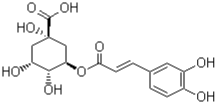
Chlorogenic acid
Myristicin
• Myristicin is a phenylpropene compound found in small amounts in the essential oil of nutmeg, parsley, and dill.
• Inhibits chemical carcinogenesis and induces apoptosis [13].
• Induces rat and human cytochrome P450 enzymes and glutathione S-transferases.
• Has very potent hepatoprotective activity.

Myristicin
Luteolin
• Antioxidant flavonoid which inhibits VEGF-induced angiogenesis [14].
• Inhibitor of the catalytic activity of phosphoinositide 3-kinase (PI(3)K), whereas inhibition of PI(3)K by luteolin affects apoptosis via PI(3)K/Akt (protein kinase B; PKB) pathways and antimitotic effects via PI(3)K/p70S6K pathways.
• Inhibitor of fatty acid synthase (FAS) and apoptosis inducer.

Luteolin
Ginger
There are many traditional uses for ginger, but more recent interest in the use of ginger focuses on the prevention and management of nausea. Ginger may play a role in osteoarthritic pain and cancer. However, there is limited clinical information to support these uses. It is also used for discontinuing selective serotonin reuptake inhibitor (SSRI) drug therapy [15]. Over 400 different compounds have been identified in ginger. The main components are [6]-gingerol and [6]-shogaol; however, the pharmacologically active compounds [6] - and [10]-dehydrogingerdione and [6] - and [10]-gingerdione have also been identified. Active constituents of ginger include gingerol, gingerdione, shogaol, and sesquiterpene and monoterpene volatile oils.

6-Gingerol 6-Shogaol
Ginseng
Ginseng is popularly used for its adaptogenic, antineoplastic, immunomodulatory, cardiovascular, CNS, endocrine, and ergogenic effects, but these uses have not been confirmed by clinical trials.
Most traditional ginseng herbal preparations contain saponin (ginsenosides) glycoside. Ginseng root is standardized on content of ginsenosides. Most of the pharmacological effects of ginseng are attributed to ginsenosides [16]. Ginsenosides have been shown to interact with numerous membrane proteins such as ion channels, transporters and receptors, which lead to a broad range of physiological activities. Ginsenoside Rg1 affects the expressions of genes involved in vascular constriction, cell adherence, coagulation, cell growth and signal transduction in TNF-α stimulated human umbilical vein endothelial cells (HUVECs). Ginsenoside Rg1 regulates sets of genes in endothelial cells and protects endothelial cells from TNF-α activation.
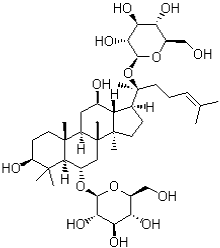
Ginsenoside Rg1
S-adenosyl-L-methionine (SAMe)
S-adenosyl-L-methionine (SAMe), a popular alternative to conventional antidepressants, appears to affect levels of dopamine, norepinephrine, and serotonin. Imaging studies suggest that it affects brain activity similar to conventional antidepressants [17]. SAMe is effective for depression, but so far, there is no reliable evidence that it works for anxiety disorders. Don't recommend it.
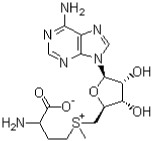
S-adenosyl-L-methionine (SAMe)
There is a lot of interest in herbal alternatives for their use as sedatives, hypnotics, and anxiolytics.
Kava
Kava tea has a long history of use among Pacific Islanders for a calming effect and promotes sociability. In North America, kava extract capsules are being used for their calming effects and as a treatment for anxiety. Kava extracts are thought to have a variety of effects including anxiolytic, sedative, anticonvulsant, and analgesic. Kava does not seem to affect benzodiazepine receptors, but it might increase the effects of GABA by increasing GABA binding sites [18].
Kava has been safely used in short-term clinical trials. But hepatotoxicity can occur in some patients after as little as 3-4 weeks of use, even in normal doses. Slow metabolizers or those patients deficient in cytochrome P450 2D6 are theorized to be more susceptible [18].The compounds of utmost pharmacological interest in Kava extracts are the substituted a -pyrones or kava pyrones, commonly called kavalactones. Fifteen lactones have been isolated from kava rootstock. The following six compounds are present in the highest concentrations and account for approximately 96 percent of the lipid resin: yangonin, methysticin, dihydromethysticin, kavain, dihydrokavain, and demethoxyyangonin (5, 6-dehydrokavain) [19,20]. Structures for the three major kavalactones are shown below.

Kavain methysticin 10-methoxyyangonin
In vitro and in vivo analysis carried out on hepatic and intestinal CYP enzymes of rat, have demonstrated that ginkgolic acids were shown to be potent inhibitors of CYP1A2, CYP2C9 and CYP2C19. The variations of constituents of gingko (ginkgolides, biobalides, and flavone glycosides) and their bioavailability could explain the disparity in findings, in addition to species variability in drug metabolism.
During the course of conventional drug treatment for Alzheimer’s disease, fewer than 20% of patients are reasonable responders. Pharmacogenomics studies have shown that the therapeutic response is genotype specific as pharmacogenomics factors account for more than 60% of drug variability in drug disposition. Some natural medicines tend to inhibit acetylcholinesterase activity.
Huperzine A
Huperzine A is an alkaloid isolated from Huperzia serrata (Chinese club moss). It is a specific acetylcholinesterase inhibitor with a longer duration of action than donepezil (Aricept) or tacrine (Cognex) [21,22]. It also has N-methyl-D-aspartate (NMDA) receptor antagonist properties in animal models similar to memantine (Namenda) [23]. It protects cells against hydrogen peroxide, β-amyloid protein, glutamate, ischemia and staurosporine-induced cytotoxicity and apoptosis. Prospective agent for the treatment of Alzheimer‘s disease.
No clinical research has evaluated huperzine A in patients with moderate to severe Alzheimer's disease. There is some clinical evidence that huperzine A can improve cognitive and behavioral function in Alzheimer's patients [23]. Most studies have included only small numbers of patients and for short treatment periods. More evidence of long-term safety and effectiveness gas not been established yet.
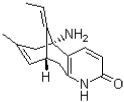
Huperzine A ((+/-)-Selagine)
Rosmarinic acid
Rosmarinic acid is an ester of caffeic acid, and 3, 4-dihydroxyphenyllactic acid. It is a major ingredient of the culinary herb sage (Salvia officinalis) and lemon balm (Melissa officinalis), a plant that has shown promising signs of therapeutic activity in patients with Alzheimer’s disease [24]. Main activities of rosmarinic acid include antioxidant, anti inflammatory, antimutagen, antibacterial, and antiviral properties [25]. Currently research studies are underway at CNUCOP on pharmacokinetic and mechanistic aspects of rosmarinic acid that target its use in the treatment of alzheimer’s disease [26].

Rosmarinic acid
Gotu kola
Gotu kola, Centella asiatica, a plant grown in India and southern Africa. The three asiaticoside derivatives in Gotu kola extract show some neuroprotective effects. In vitro, the asiatosides, asiatic acid, asiaticoside 6, and SM2 are able to block cell death induced by betaamyloid [27]. But, there is no evidence yet that it helps patients with Alzheimer's disease.
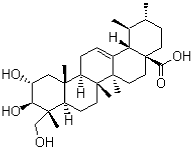
Asiatic acid
Some natural medicines are thought to have some pharmacological effects that are similar to statins.
Garlic
Garlic is one of the most vigorously researched supplements around. Garlic contains a variety of organosulfur constituents with biological activity. The active constituents in garlic are thought to inhibit cholesterol synthesis by blocking enzymes such as HMGCoA reductase, squalene epoxidase, and glucose-6-phosphate dehydrogenase [28]. The research studies which claimed these activities were generally were often small, flawed, and inconsistently designed.
However more recent research has been consistent in the opposite direction. These studies show that a variety of garlic preparations do not significantly reduce cholesterol levels [29]. Some garlic preparations can induce cytochrome P450 3A4. Some studies have shown no effect of garlic on drug metabolism. Preparations that give a higher amount of the constituent allicin appear to be more likely to cause interactions [30].

Allicin (S-Allyl acrylo-1-sulphinothioate)
Artichoke extract
Artichoke extract contains cynaroside and its derivative luteolin. Both of these constituents seem to block HMG-CoA reductase, similar to statins [31]. Artichoke extract seems to be safe for most patients. But some people can experience flatulence after starting artichoke extract.

Cynaroside Luteolin
Pomegranate juice
Researchers are also taking an interest in studying pomegranate juice for prostate cancer, high cholesterol, atherosclerosis, COPD, hypertension, and other potential uses. But for all these uses, research is just in its infancy.
For hypertension, some research shows that pomegranate can reduce the activity of ACE by about 36% [32]. Clinical research is contradictory, some research shows modest reductions in systolic blood pressure after drinking 50 mL/day for up to a year [33]. Other research shows no benefit after drinking 240 mL/day for 3 months. Ellagic acid was found to be the major active ingredient in the pomegranate juice.
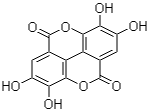
Ellagic acid
Approximately 89% of patients with asthma use some form of alternative medicine. About a quarter of these patients use an herbal or other natural medicine [34].
Over 160 natural ingredients have identified that are used or promoted for treating or preventing asthma. Of these, only about 25 have been clinically studied for treating asthma. Several of these natural medicines have effects on inflammatory mediators with some similarities to leukotriene modifiers or corticosteroids.
Butterbur
Butterbur is best known as a remedy for allergies, but it is also promoted for asthma and many other respiratory conditions. Butterbur and the butterbur constituent "petasin" appear to decrease synthesis of leukotrienes in vitro [35,36]. Although butterbur has substantial clinical research supporting its use for allergic rhinitis, there is no reliable clinical research that it is effective for asthma. Butterbur naturally contains unsaturated pyrrolizidine alkaloids (UPAs), which are hepatotoxic, carcinogenic, and mutagenic.

Petasin
In spite of the success of natural products with their structural diversity and tremendous value as therapeutics, drug discovery for natural products faces many challenges. Several of these real and perceived limitations of natural products include their chemical complexity; bioavailability problems and poor water solubility and lack of sufficient solubility enhancement studies; the difficulty and timeconsuming nature of screening of mixtures of compounds in natural product extracts; the apparently common occurrence of synergistic actions between different components in an extract and solubility issue once the compounds in question are isolated in pure form; adulterations and poor reproducibility between different batches of extracts; and the uncertainty of being able to obtain resupplies of an interesting extract in large quantities.
The US National Institutes of Health (NIH) and executives from the drug companies announced 3rd May 2012 that 24 drugs abandoned during development by three major pharmaceutical companies will become available to scientists seeking novel therapeutic uses under the notion ‘Teach old drugs new tricks’. It is a good news for the natural products drug discovery groups, academics, non-profit groups, biotechnology companies and others. Several natural compounds that were tested during clinical stages of drug development but were abandoned because they didn’t work for the intended purpose or because of lack of sufficient data will have a better chance with this current approach. Based on preliminary research data, majority of natural products databases downgrade commonly used natural medicines to a rating of ‘Possibly Ineffective’ for most of useful indications used by consumers. Pharmacogenomic factors were not looked at for almost all the natural agents abandoned during the clinical trials. Pharmacogenomics could be a reason for the lack of potency and intrinsic toxicity of several natural medicines? It is hoped that new approach with improved and effective application of natural products will improve the drug discovery process.
From the above examples it is clear that there are number of natural products that can prevent or cure numerous life threatening diseases by interacting with genes. It is obvious that optimizing the assessment of natural products as drug leads requires multidisciplinary collaboration to recuperate the usefulness of commonly used natural medicines and compounds originated from plants, plants tissue culture, soil and marine microorganisms which didn’t make it to later stages of drug development [36].
With a view to promoting more effective and safe natural medicines, clinical studies need to be reviewed in order to include pharmacogenomic studies of natural products. It may be that some abandoned natural agents can offer improved outcomes with relatively little investment and cost. More open discussion on how pharmacogenetics can improve existing therapies is vital if this is to become a reality in the future research endeavor. There is hope that those compounds which passed through preclinical testing and through phase I safety trials in humans, but were abandoned later for lack of efficacy will come into life in the future.